Adam Mills
Vice President of Teaching and Learning, Ontario Association of Physics Teachers
Department Head of Science, Assumption College Catholic High School
adam_mills@wecdsb.on.ca
This article is the first in a two-part series surrounding the development of an inquiry-based optics unit for grade 10 Science. The focus of this first article is to provide the reasoning why inquiry-based optics is needed in Science 10 and some of the important ideas that I introduce to help battle the preconceptions students hold.
I taught Science 10 for the first time in a while last year, and I have it again this year (by request). After changing the way I taught Physics 11 and 12 to a more inquiry-based style, I decided to do something similar with Science 10. This in turn led me down a path towards more effectively introducing optics to my students. In speaking with other teachers, I quickly found that the simplicity of the mathematics in the optics unit can often mask serious conceptual difficulties. I began to look at what Physics Education Research had to say about the common conceptual misunderstandings and came across the following series of questions asked by Goldberg and McDermott in their 1987 paper [1].
The set of three questions were all based on the simple diagram below.
 Question 1:
Question 1:
If the lens were removed, leaving the object and the screen where they are, would anything change?
- The image would be upright
- The image stays the same
- No image would form
- The size could change
Question 2:
Suppose a piece of cardboard was placed over the top half of the lens, would anything change on the screen?
- No, it would show the exact same image
- It would be the same size but less bright
- There would be no image
- Half the image would appear
Question 3:
In the current configuration a clear image is formed on the screen. If you were to change the distance between the lens and the screen would anything change about the image on the screen?
- The image stays the same
- The image changes in size
- The image becomes somewhat fuzzy
- The image disappears
These questions were given to students who had completed a first-year university level physics course. In all three cases, the majority of students answered the questions incorrectly, with question #2 having 75% of the students provide an incorrect response.
These results clearly demonstrate the conceptual misunderstandings students have even after direct instruction. Most of these misconceptions are centred around the following ideas [2]:
- Most students do not understand the ray model of light.
- Students treat rays as physical objects, not abstract representations.
- Students do not understand the role of the three principal rays.
- Students do not understand the role of a converging lens in image formation.
- Students do not understand the role of the screen in image formation.
- Students do not understand the role of the eye in ‘seeing’ images.
With these misconceptions in mind I began to develop inquiry-based lessons to directly address these issues in hopes of having students develop a better conceptual understanding of geometric optics. In order to accomplish this, the students have constant access to a laser pointer, a flat mirror, a double concave lens, a double convex lens, a semi circular prism and a ray box.
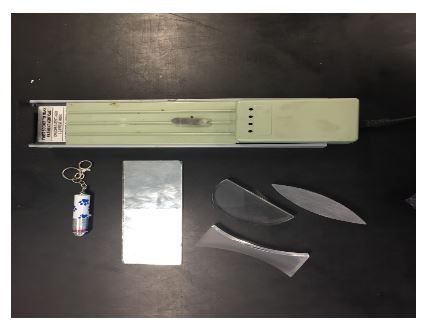
From a content point of view I do very little with mirrors asides from the law of reflection and the difference between specular and diffuse reflection. This means I do nothing with curved mirrors. The reason for this is that I find curved mirrors provide no new physics in terms of how rays bend at an interface compared with lenses and they only form virtual images. As a result, I find curved mirrors to be more abstract compared to lenses with little added benefit to the students in terms of conceptual knowledge.
Lesson 1:
In the first lesson the students complete (which may be found
HERE) they begin to develop the ray model for light. To accomplish this, they use a raybox as a light source and are asked to describe how the light travels and what happens to the intensity as the screen gets further from the source. Using these observations they create a provisional ray model. But this is only a part of the knowledge building process. They must now be given the opportunity to test their newly developed model to see if it makes accurate predictions or describes other phenomena. They are asked if the creation of shadows helps verify the fact that light travels in a straight line (which it does). Then they are asked to use a laser pointer as a light source. They quickly observe via chalk dust that it too travels in a straight line; however, the intensity does not really vary with distance (even with the cheap dollar store ones!). The students now have a contradiction with their initial model.
To explain this contradiction it is important to introduce the idea of how our eyes actually perceive brightness and therefore intensity.
With the class we discuss that our perceived brightness is a function of how many rays enter our eyes. The more rays that enter the brighter we perceive the object. Then we discuss the observation that the rays from the ray box diverges, while the rays from the laser pointer do not.
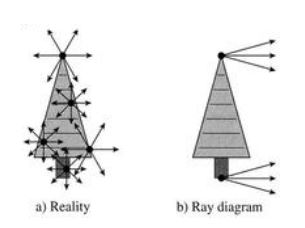
It is vital to show that rays diverge from the point light source in
all directions. I draw extra ones in the direction of the eye since that is the area we care about in this scenario. It becomes clear that as we move further from the source less rays enter our eye. Therefore, we perceive the light to be dimmer. If we were able to increase the size of our eye as we moved away, the brightness would not change.
However, with a laser light source where the light is directional and does not diverge, the same number of rays enters our eyes regardless of our distance from the source. Note this is just an explanation — do not actually have the students direct the laser into their eyes!
Another critical point that comes about in future lessons is the fact that an object is a source of light rays and that there is no difference between self luminous objects and reflective objects. Every object has rays that originate from
every point on the object and
every point sends rays in
all directions (see figure below). When we draw a ray model we often only show the rays emerging from some ‘special’ points and only in the direction that we are interested in. These simplifying assumptions may be made later only after the students explicitly understand the ray model of light. It is also likely that these simplifying assumptions, if made too early, are directly responsible for their incorrect answering of questions #1 - 3.
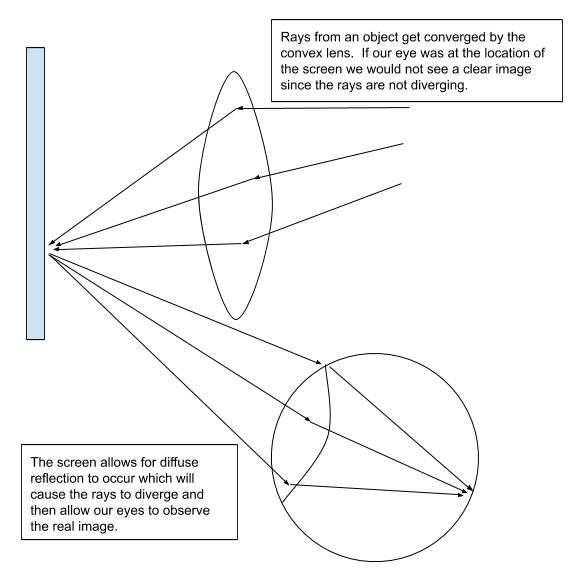
With these simple adjustments to my initial lessons I have found that the students have begun to develop a much stronger understanding of the ray model of light.
A final important point that I discuss very early in the optics unit is the basic function of our eyeball. The vital idea is that our eyes tend to require diverging rays to enter it in order to ‘see’ an image. I find that the terms “real” image and “virtual” image are very confusing to the students, and the idea of how our eye works helps to reduce this confusion.
A concave lens will always produce a virtual image. This is because we cannot place a screen to capture the image, but it does not mean that we cannot see an image. In fact, using a concave lens we will always see a clear image when we look through it with our eye since it always creates diverging rays. A convex lens will converge the light rays (most of the time) thus we need a screen to ‘capture’ the image, which will then undergo diffuse reflection creating diverging rays which we can see with our eyes.
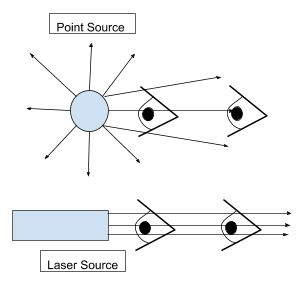
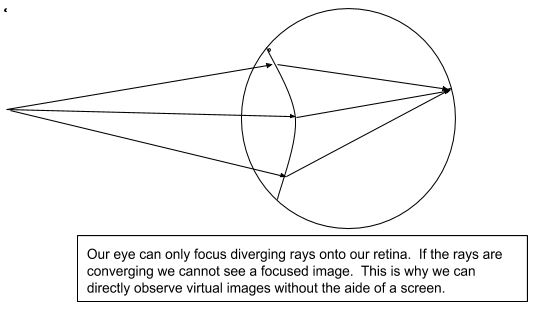
Therefore, we must really differentiate between ‘seeing an image’ and ‘seeing an image on a screen’.
In the next article I plan to discuss some of the ideas I use when dealing with lenses, as well as the cooperative group problem solving I have the students complete.
References
- F. M. Goldberg and L.C. McDermott, “An investigation of student understanding of the real image formed by a converging lens or concave mirror (abstract)”. Am. J. Phys. 55 (2), February 1987.
- R. Knight, Five Easy Lessons: Strategies for Successful Physics Teaching, Pearson Education, 2004.
Tags: Optics







